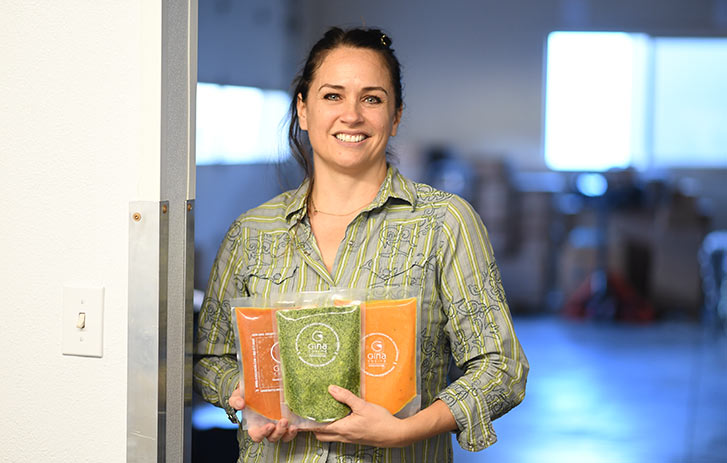Crowdfunding for small businesses



FedEx Small Business Grant Contest winners Kelly McCollum and Marcie Colledge are two scientists and moms with a mission – get girls hooked on science early.
While women make up half of the workforce, they hold only a quarter of science and technology jobs, according to census data. Kelly and Marcie want to change those statistics.
They developed the idea to create and sell a rigorous but fun science kit line, specifically aimed at girls. They hoped these kits would instill the confidence and desire in young girls to pursue careers in STEM as adults.
"They found a solution in crowdfunding — a method of raising funds via small donations from large quantities of people, usually over the internet."
Researchers by nature, the two Portland-based scientists set off to learn as much as they could about launching their own business. They needed to know how to test their concept, identify funding options, and ultimately bring their kits to market.
They found a solution in crowdfunding – a method of raising funds via small donations from large quantities of people, usually over the internet.
The financing tool met multiple objectives for the two entrepreneurs.
“We were using it to raise capital to build our inventory and pay for manufacturing,” says Marcie of their decision to try crowdfunding. “But we also wanted to use it as a platform to engage our customer base and test the validity of our product.”
After researching the ins and outs of various platforms, Marcie and Kelly launched a campaign for their science kit company, Yellow Scope, on the crowdfunding platform Kickstarter in 2014.
Kelly and Marcie believed that crowdfunding campaigns that build early momentum and make fast progress gaining backers in the days immediately after launch tended to have an advantage over those campaigns with a slow start. They set off to start their campaign with a bang – priming their contacts to donate any dollar amount as soon as the crowdfunding effort launched.
Their strategy worked. Kelly and Marcie raised half of their $25,000 goal in less than 36 hours. By the end of their month-long campaign, more than 500 backers contributed more than $33,000, exceeding the initial goal.
Marcie and Kelly attribute much of the success of their campaign to their research-based strategy. Here, they share some of the planning and pointers that helped guide them.



Five tips for planning a crowdfunding campaign
1. Research crowdfunding sites to find what's best for you
There is a crowdfunding site for nearly every need.
- Equity-based crowdfunding platforms, like Fundable and Seed Invest, offer backers a share of your venture in exchange for their capital.
- Crowdfunding sites that raise money for nonprofits include Causes, which only accepts campaigns from registered 501(c)(3) and 501(c)(4) charitable organizations, and Razoo, a platform that lets nonprofits host a “giving day.”
- There are also a variety of niche platforms that target communities of contributors based on their passions. For example, Slated provides funding for film projects, and Experiment finances scientific research.
- Kickstarter and Indiegogo are crowdfunding sites that allow an entrepreneur or “creator” to present the plan for a project or business to the community, set a fundraising goal, and build a critical mass of people who contribute funds to their idea in return for a prototype of the finished product or other rewards designated by the campaign.
In the case of Marcie and Kelly, they chose to launch their campaign through Kickstarter, in part because it is an all-or-nothing funding platform. That means a creator can only keep the money raised from a crowdfunding effort if backers meet a pre-stated campaign goal. Marcie and Kelly thought the high-stakes nature of an all-or-nothing crowdfunding campaign would motivate their backers to take action.
When choosing the platform that’s best for you, also consider other criteria, like the size of the community the site reaches and the percentage of funds the platform keeps from each campaign.
2. Be wise about your goal
Marcie and Kelly thought long and hard about their monetary goal before launching the campaign. The all-or-nothing nature of Kickstarter made it critical to set the right dollar amount. In fact, only 37% of Kickstarter campaigns are successfully funded, so the risk of failing was very real. If they set their dollar amount too high, they might not reach their goal; too low and they might seem uncertain of their idea’s chance of success, or worse – underfund their project.
Before launching the campaign, the Yellow Scope entrepreneurs researched exactly what they would need to send their science kits into production. They priced all costs for creating 1,500 kits – including the Kickstarter fee, materials, manufacturing, and shipping costs. They came up with a funding gap of $25,000, which became their Kickstarter goal.
Additionally, Kickstarter offers the option of creating “stretch goals.” These goals allow campaigns to raise additional funds above their initial target without risk of losing their donations if they do not meet the stretch goal. This helped Yellow Scope exceed their initial $25,000 goal by approximately 30%.
3. Simplify your reward levels
Kickstarter campaigns offer various levels of rewards to their backers. “Keep the reward levels simple,” says Marcie. “Some people go crazy and have a lot of extra merchandise. That’s a lot of cost and a lot to manage.”
Marcie and Kelly say their main reward level was $50, which allowed a backer to receive a finished science kit after production was complete. Higher donation levels included the gift of a lab coat.
“Make room for a variety of people to support you, depending on their level of interest,” says Kelly.
On the low end, some contributors might donate just a dollar, and Yellow Scope provided them a “thank you” and a shout-out on social media. On the high end, there were contributors who gave larger sums of money because they supported the mission but had no need for science kits. They provided these contributors a “medal” as recognition.
Marcie and Kelly also created a special reward level for backers in their home city of Portland, Oregon. They promised to hand deliver the finished science kit prototypes to backers in their community to create an added personal touch. The two Yellow Scope scientists were delighted to meet excited girls at the point of delivery. “One little girl ran and got her science fair poster board,” says Kelly. “She just couldn’t wait to show me.”
4. Consider your timing
You can set the date your campaign runs and the length of the effort. Marcie and Kelly planned to launch their funding campaign during the holiday shopping season from November to December 2014. They say this was strategic, as many backers would be in the holiday shopping mindset during this time and might be more likely to contribute to a Kickstarter campaign that would eventually provide the gift of a science kit.
Additionally, it was important to accurately promise the delivery date of the prototypes. Kickstarter campaigns are notoriously late in doling out finished products to backers. Kelly and Marcie wanted to show that Yellow Scope followed through on its promises, so they thoughtfully allotted three months to produce and deliver the science kits on schedule.
5. Develop a communications plan
“Build the buzz and prime your audience to hit the ground running on day one of your campaign,” says Marcie.
They developed a communications plan in advance of launch to prepare their contacts and galvanize as many supporters to donate as soon as possible after launch. They developed email lists and posted on social media to let friends, family, and other contacts know their campaign was coming and then continued updating their networks on the status of their fundraising efforts after the campaign launched.
Additionally, Marcie and Kelly reached out to influencers who supported Yellow Scope’s mission to help drive additional traffic to the Kickstarter page. Fellow Portlander and author of the book Wild, Cheryl Strayed, tweeted a link to the funding page. Additionally, the president of Harvey Mudd College and an advocate for women in STEM, Maria Klawe, supported the effort.
Kickstarter itself also served as a communication vehicle. Kelly and Marcie posted regular updates and video content on their Kickstarter page. Then upon completion of their campaign, the entrepreneurs added their backers to a newsletter (with an opt-out option) to create an ongoing line of communication with their contributors.
Interested in learning more about Yellow Scope? Check out how a passion for turning girls onto science has driven every aspect of this company’s development:
Note: The information provided in this website does not constitute legal, tax, finance, accounting, or trade advice, but is designed to provide general information relating to business and commerce. The FedEx Small Business Center’s content, information and services are not a substitute for obtaining the advice of a competent professional, for example a licensed attorney, law firm, accountant, or financial adviser.
Related reading

9 ways to stay on budget with smart shipping
Get simple tips for getting the most value and savings with FedEx. These include signing up for discounts and rewards, and more.
read article
Exploring angel investing
Owner, Gina Cucina, details why she decided to seek angel investing for her small, growing business.
read article
Crowd-funding for small business
Small business owners Kelly McCollum and Marcie Colledge from Yellow Scope share the secrets of successful crowdfunding.
read article